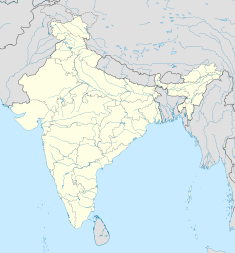ถ้ำเอลโลรา
| หมู่ถ้ำเอลโลรา | |
|---|---|
 ถ้ำหมายเลข 16 ไกรลาศนาถมนเทียร | |
| ประเภท | หมู่ถ้ำเจาะหิน |
| ที่ตั้ง | อำเภอออรังกาบาด, รัฐมหาราษฏระ, ประเทศอินเดีย |
| พิกัด | 20°01′36″N 75°10′38″E / 20.0268°N 75.1771°E |
| ประเภท | วัฒนธรรม |
| เกณฑ์ | i, iii, vi |
| ขึ้นเมื่อ | 1983 (7th session) |
| เลขอ้างอิง | 243 |
เอโลรา (Ellora; \e-ˈlȯr-ə\) หรือนิยมทับศัพท์อิงชื่อภาษาอังกฤษว่า เอลโลรา หรือชื่อในภาษามราฐี เวรูละ (มราฐี: वेरूळ; ไอเอเอสที: Vērūḷ) เป็นแหล่งมรดกโลกโดยยูเนสโกตั้งอยู่ที่อำเภอออรังกาบาด รัฐมหาราษฏระ ประเทศอินเดีย เป็นหมู่ศาสนสถานและวิหารเจาะหิน (rock-cut) ที่ใหญ่ที่สุดแห่งหนึ่งของโลก ประกอบด้วยงานศิลปะและโบราณสถานของศาสนาฮินดู, ศาสนาพุทธ และศาสนาไชนะ อายุราวปี 600–1000[1][2] ถ้ำหมายเลข 16 ถือเป็นสถาปัตยกรรมเจาะหินก้อนเดี่ยว (single monolithic rock excavation) ที่ใหญ่ที่สุดในโลก ภายในถ้ำหมายเลข 16 คือไกรลาศมนเทียร และราชรถที่สร้างขึ้นเพื่อบูชาพระศิวะ[3][4][5]
ปัจจุบันค้นพบถ้ำมากกว่า 100 ถ้ำในหมู่ถ้ำเอโลรา ทั้งหมดสร้างขึ้นโดยการเจาะเข้าไปในหน้าผาหินบะซอลต์ในหมู่เทือกเขาจารนันทรี (Charanandri Hills) ปัจจุบันมีเพียง 34 ถ้ำที่เปิดให้เข้าชมสำหรับสาธารณชน[3] ในจำนวนนี้ประกอบด้วยวิหารในศาสนาพุทธ 12 แห่ง (ถ้ำหมายเลข 1–12), ฮินดู 17 แห่ง (ถ้ำหมายเลข 13–29) และไชนะ 5 แห่ง (ถ้ำหมายเลข 30–34)[6][7] ภายในแต่ละวิหารเจาะหินเป็นการแสดงถึงศิลปกรรมและความเชื่อที่แพร่หลายในสหัสวรรษที่หนึ่ง และสร้างตามความเชื่อของแต่ละศาสนา[6] การก่อสร้างให้อยู่ใกล้ชิดกันเช่นนี้เป็นการแสดงถึงความกลมเกลียวระหว่างศาสนา[2][8] หมู๋วิหารทั้งหมดล้วนสร้างขึ้นในจักรวรรดิราษฏรกูฏ (สำหรับวิหารพุทธและฮินดู) และจักรวรรดิยาทวะ (วิหารไชนะ) สนับสนุนการก่อสร้างโดยกษัตริย์ ขุนนาง และผู้ค้าขายที่มั่งคั่งในแต่ละยุคสมัย[3][9]
อ้างอิง
[แก้]- ↑ Owen 2012, pp. 1–2.
- ↑ 2.0 2.1 "Ellora Caves – UNESCO World Heritage Centre". Whc.unesco.org. 6 March 2008. สืบค้นเมื่อ 12 August 2010., Quote: "These 34 monasteries and temples, extending over more than 2 km, were dug side by side in the wall of a high basalt cliff, not far from Aurangabad, in Maharashtra. Ellora, with its uninterrupted sequence of monuments dating from A.D. 600 to 1000, brings the civilization of ancient India to life. Not only is the Ellora complex a unique artistic creation and a technological exploit but, with its sanctuaries devoted to Buddhism, Hinduism and Jainism, it illustrates the spirit of tolerance that was characteristic of ancient India."
- ↑ 3.0 3.1 3.2 World Heritage Sites – Ellora Caves, Archeological Survey of India (2011), Government of India
- ↑ John Stratton Hawley (1981), Scenes from the Childhood of Kṛṣṇa on the Kailāsanātha Temple, Ellora, Archives of Asian Art, Vol. 34 (1981), pp. 74–90
- ↑ M. K. Dhavalikar (1982), "KIlasa – The Stylistic Development and Chronology", Bulletin of the Deccan College Research Institute, Vol. 41, pp. 33–45
- ↑ 6.0 6.1 Lisa Owen (2012). Carving Devotion in the Jain Caves at Ellora. Brill Academic. pp. 1–10. ISBN 978-9004206298.
- ↑ อ้างอิงผิดพลาด: ป้ายระบุ
<ref>ไม่ถูกต้อง ไม่มีการกำหนดข้อความสำหรับอ้างอิงชื่อBrockman2011p155 - ↑ Time Life Lost Civilizations series: Ancient India: Land Of Mystery (1994)
- ↑ Gopal, Madan (1990). K.S. Gautam (บ.ก.). India through the ages. Publication Division, Ministry of Information and Broadcasting, Government of India. p. 178.



